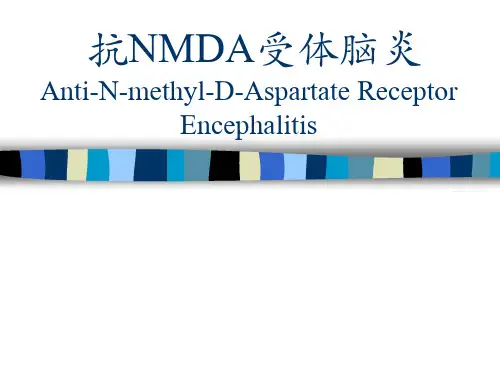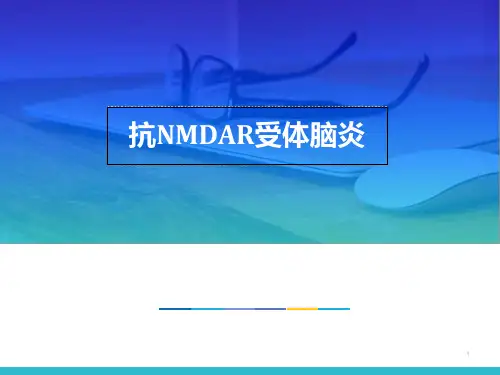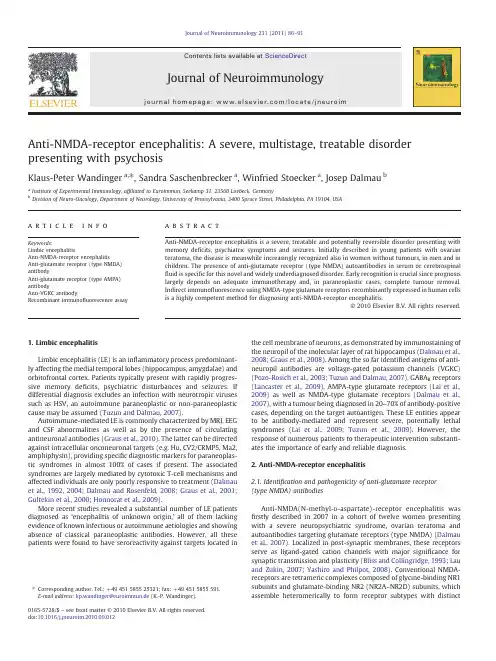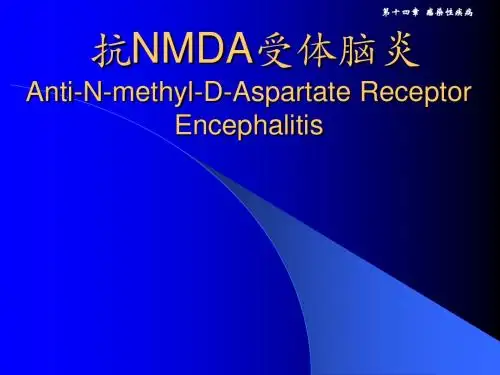抗NMDAR受体脑炎课件
- 格式:ppt
- 大小:935.00 KB
- 文档页数:52










Anti-NMDA-receptor encephalitis:A severe,multistage,treatable disorder presenting with psychosisKlaus-Peter Wandinger a ,⁎,Sandra Saschenbrecker a ,Winfried Stoecker a ,Josep Dalmau ba Institute of Experimental Immunology,af filiated to Euroimmun,Seekamp 31,23560Luebeck,GermanybDivision of Neuro-Oncology,Department of Neurology,University of Pennsylvania,3400Spruce Street,Philadelphia,PA 19104,USAa b s t r a c ta r t i c l e i n f o Keywords:Limbic encephalitisAnti-NMDA-receptor encephalitisAnti-glutamate receptor (type NMDA)antibodyAnti-glutamate receptor (type AMPA)antibodyAnti-VGKC antibodyRecombinant immuno fluorescence assayAnti-NMDA-receptor encephalitis is a severe,treatable and potentially reversible disorder presenting with memory de ficits,psychiatric symptoms and seizures.Initially described in young patients with ovarian teratoma,the disease is meanwhile increasingly recognized also in women without tumours,in men and in children.The presence of anti-glutamate receptor (type NMDA)autoantibodies in serum or cerebrospinal fluid is speci fic for this novel and widely underdiagnosed disorder.Early recognition is crucial since prognosis largely depends on adequate immunotherapy and,in paraneoplastic cases,complete tumour removal.Indirect immuno fluorescence using NMDA-type glutamate receptors recombinantly expressed in human cells is a highly competent method for diagnosing anti-NMDA-receptor encephalitis.©2010Elsevier B.V.All rights reserved.1.Limbic encephalitisLimbic encephalitis (LE)is an in flammatory process predominant-ly affecting the medial temporal lobes (hippocampus,amygdalae)and orbitofrontal cortex.Patients typically present with rapidly progres-sive memory de ficits,psychiatric disturbances and seizures.If differential diagnosis excludes an infection with neurotropic viruses such as HSV,an autoimmune paraneoplastic or non-paraneoplastic cause may be assumed (Tuzun and Dalmau,2007).Autoimmune-mediated LE is commonly characterized by MRI,EEG and CSF abnormalities as well as by the presence of circulating antineuronal antibodies (Graus et al.,2010).The latter can be directed against intracellular onconeuronal targets (e.g.Hu,CV2/CRMP5,Ma2,amphiphysin),providing speci fic diagnostic markers for paraneoplas-tic syndromes in almost 100%of cases if present.The associated syndromes are largely mediated by cytotoxic T-cell mechanisms and affected individuals are only poorly responsive to treatment (Dalmau et al.,1992,2004;Dalmau and Rosenfeld,2008;Graus et al.,2001;Gultekin et al.,2000;Honnorat et al.,2009).More recent studies revealed a substantial number of LE patients diagnosed as ‘encephalitis of unknown origin,’all of them lacking evidence of known infectious or autoimmune aetiologies and showing absence of classical paraneoplastic antibodies.However,all these patients were found to have seroreactivity against targets located inthe cell membrane of neurons,as demonstrated by immunostaining of the neuropil of the molecular layer of rat hippocampus (Dalmau et al.,2008;Graus et al.,2008).Among the so far identi fied antigens of anti-neuropil antibodies are voltage-gated potassium channels (VGKC)(Pozo-Rosich et al.,2003;Tuzun and Dalmau,2007),GABA B receptors (Lancaster et al.,2009),AMPA-type glutamate receptors (Lai et al.,2009)as well as NMDA-type glutamate receptors (Dalmau et al.,2007),with a tumour being diagnosed in 20–70%of antibody-positive cases,depending on the target autoantigen.These LE entities appear to be antibody-mediated and represent severe,potentially lethal syndromes (Lai et al.,2009;Tuzun et al.,2009).However,the response of numerous patients to therapeutic intervention substanti-ates the importance of early and reliable diagnosis.2.Anti-NMDA-receptor encephalitis2.1.Identi fication and pathogenicity of anti-glutamate receptor (type NMDA)antibodiesAnti-NMDA(N-methyl-D -aspartate)-receptor encephalitis was firstly described in 2007in a cohort of twelve women presenting with a severe neuropsychiatric syndrome,ovarian teratoma and autoantibodies targeting glutamate receptors (type NMDA)(Dalmau et al.,2007).Localized in post-synaptic membranes,these receptors serve as ligand-gated cation channels with major signi ficance for synaptic transmission and plasticity (Bliss and Collingridge,1993;Lau and Zukin,2007;Yashiro and Philpot,2008).Conventional NMDA-receptors are tetrameric complexes composed of glycine-binding NR1subunits and glutamate-binding NR2(NR2A –NR2D)subunits,which assemble heteromerically to form receptor subtypes with distinctJournal of Neuroimmunology 231(2011)86–91⁎Corresponding author.Tel.:+49451585525321;fax:+494515855591.E-mail address:kp.wandinger@euroimmun.de (K.-P.Wandinger).0165-5728/$–see front matter ©2010Elsevier B.V.All rights reserved.doi:10.1016/j.jneuroim.2010.09.012Contents lists available at ScienceDirectJournal of Neuroimmunologyj o u r n a l h om e p a g e :w w w.e l s ev i e r.c o m /l o c a t e /j ne ur o i msynaptic localization,physiological and pharmacological properties (Fig.1)(Dingledine et al.,1999;Ishii et al.,1993;Lynch et al.,1995;Qiu et al.,2005).Autoantibodies in the serum or cerebrospinal fluid (CSF)of patients with anti-NMDA-receptor encephalitis were shown to bind speci fically to an epitope located in the extracellular domain of the NR1subunits (Dalmau et al.,2008).Immune-mediated pathogenesis of anti-NMDA-receptor enceph-alitis is likely because patients frequently improve with immuno-therapeutic treatment or tumour resection.A pathogenic role was ascribed to the antibodies based on the finding that they cause a reversible reduction in glutamate receptors (type NMDA)on the cell surface of neurons,and due to immunopathological findings (Dalmau et al.,2008;Hughes et al.,2010;Tuzun et al.,2009).Furthermore,a pharmacological blockade of the receptors with NMDA antagonists in animals causes clinical symptoms similar to those of anti-NMDA-receptor encephalitis (Manahan-Vaughan et al.,2008;Stone et al.,2007).2.2.Disease course,treatment,prognosisSince the first patients with anti-NMDA-receptor encephalitis were diagnosed in 2007,the number of documented cases has increased manifold,suggesting that this disorder is not rare.Initially described mainly in young women with ovarian teratoma,diagnosis has been reported in the meantime also for older patients,women without teratoma,men and children (some with teratoma).Noteworthy,in a recent study the diagnosis was made in a panel of patients comprising 40%adolescents and children aged below 18years with the youngest being 23months old (Dalmau et al.,2008;Florance et al.,2009;Schimmel et al.,2009).A stereotypical clinical course occurring in phases is typical for anti-NMDA-receptor encephalitis.A non-speci fic flu-like prodrome (subfebrile temperature,headache,fatigue)is always followed by a psychotic stage with bizarre behaviour,disorientation,confusion,paranoid thoughts,visual or auditory hallucinations and memory de ficits.Because of these features a large proportion of patients end up in psychiatric therapy,and in many cases a drug-induced psychosis is initially diagnosed.In the following phase,decreased consciousness,hypoventilation,lethargy,seizures,autonomous instability and dyskinesias develop.Due to the severity of this disease (coma,status epilepticus,etc.)affected individuals must often undergo treatment in intensive care units for long periods of time (Fig.2)(Dalmau et al.,2007,2008;Ferioli et al.,2010;Gable et al.,2009;Iizuka et al.,2008;Niehusmann et al.,2009;Sansing et al.,2007).About half of patients show irregularities in cerebral MRI.The EEG is pathologically altered in over 90%of persons with the disease.Investigation of CSF reveals mild lymphocytic pleocytosis in more than 90%of cases,intrathecal protein increase in 33%and oligoclonal bands in about 25%.On average,60%of patients have tumours,in which the presence of nervous tissue was proven.The probability of an associated neoplasm is dependent on age and gender.In women,the frequency of predominantly ovarian teratoma amounted to about 62%,while only 22%of men were affected (testicular teratoma and small cell lung cancer)(Dalmau et al.,2007,2008).In young females (b 18years)and children (b 14years),tumours were diagnosed in 31%and 9%,respectively (Florance et al.,2009).Prognosis of patients depends on early diagnosis,implementation of appropriate immunomodulatory therapy and,in paraneoplastic cases,complete tumour removal.Current immunotherapeuticstrategiesFig.1.Glutamate receptors (type NMDA).The receptors are located in the post-synaptic membrane and form heteromeric ligand-gated cation channels composed of NR1and NR2subunits.Anti-glutamate receptor (type NMDA)antibodies are directed against a main epitope located in the extracellular domain of the NR1subunit.Fig.2.Clinical characteristics of patients with anti-NMDA-receptor encephalitis.Dalmau et al.,2008.87K.-P.Wandinger et al./Journal of Neuroimmunology 231(2011)86–91include steroids,plasmapheresis,intravenous immunoglobulins and rituximab.In around 75%of cases a substantial regression of symptoms can be achieved.However,25%of patients suffer from severe neurological de ficits or die.Upon recovery,there is amnesia for the duration of the illness,and there is a risk of relapses of the encephalitic syndrome,the latter in particular when the tumour is removed too late or not at all or if no tumour could be found (Breese et al.,2010;Dalmau et al.,2007,2008;Iizuka et al.,2008;Wong-Kisiel et al.,2010).The gradual process of clinical recovery may take a long time (up to years)but can,in some patients,even be associated with improvement of frontotemporal brain atrophy (Iizuka et al.,2010).Moreover,it has been demonstrated recently that severe anti-NMDA-receptor encephalitis may occur during pregnancy but can have a good outcome for both the mother and the newborn (Kumar et al.,2010).2.3.Differential diagnosisDiagnosis of anti-NMDA-receptor encephalitis is based on the characteristic clinical symptoms and supporting results from brain MRI,EEG and CSF.Infectious encephalitides (especially HSV)and other autoimmune aetiologies (limbic encephalitis with autoantibo-dies against Hu,Ma2,CV2and amphiphysin)must be excluded ascause of the symptoms.Final diagnosis is based on the detection of anti-glutamate receptor (type NMDA)antibodies in the patients'serum or CSF.When a positive serological result is obtained,thorough investigations in order to detect an underlying teratoma need to be undertaken.boratory diagnosis and follow-upSo far,criteria for the presence of anti-glutamate receptor (type NMDA)antibodies included serum or CSF reactivity (i)with the hippocampal tissue on rat brain sections,(ii)cell-surface labelling of cultured hippocampal neurons,and (iii)reactivity with NR1/NR2-transfected human embryonic kidney (HEK)cells (Dalmau et al.,2008).The recombinant cell substrate proved best suitable for highly sensitive and monospeci fic antibody detection.In particular,recom-binant expression of NMDA-type glutamate receptors on the surface of human cells copes well with the challenge of this membrane-bound antigen to require synthesis and presentation in a largely authentic environment for optimal exposition of conformational epitopes.However,this approach has so far been restricted to only a few research laboratories worldwide since it necessitates sophisticated molecular biological and immunological techniques.In addition,the necessity of long-term cell line maintenance and of transfecting cells prior to each testing is labour-intensive,time-consuming and might also affect assay reproducibility.In order to generate transfected cell substrates in a standardized manner,cDNA encoding the glutamate receptor (type NMDA;subunits NR1/NR1and NR1/NR2,respectively)was inserted into eukaryotic expression vectors as described (Dalmau et al.,2008).Plasmids were transfected into HEK293cells seeded on cover glasses using polyethylenimine.48hours after transfection,the cells were fixed with acetone.Coated cover glasses were then cut automatically into millimetre-sized fragments (biochips)and used side by side with non-transfected cells in a mosaic which contained additionally frozen sections of rat hippocampus and cerebellum.Table 1Reactivity of patients and control subjects with glutamate receptor (type NMDA)expressed on the surface of recombinantly transfected HEK293cells.PanelsnNo.of samples reactive with recombinant glutamate receptor (type NMDA)Anti-NMDA-receptor encephalitis 6666Sensitivity66100%Other autoimmune encephalopathies 31–Multiple sclerosis100–Systemic lupus erythemadodes 50–Healthy blood donors 200–Speci ficity 381100%Fig.3.Serum reactivity of a patient with anti-NMDA-receptor encephalitis as detected by indirect immuno fluorescence.(A)Positive reaction with transfected HEK293cells expressing the glutamate receptor (type NMDA;subunit NR1).(B)Non-transfected HEK293cells (negative reaction).(C)Neuropilic staining of the molecular layer on rat hippocampus.(D)Staining of the granular layer on rat cerebellum.88K.-P.Wandinger et al./Journal of Neuroimmunology 231(2011)86–91Expression and reactivity of the recombinantly expressed antigens was con firmed using antibody preparations speci fically reactive with the receptor subunits NR1and NR2,respectively.The potential of the NR1/NR2substrate to detect anti-NR2antibodies is insofar of relevance since these antibodies were suggested to be involved in manifestations of neuropyschiatric lupus (NPSLE)(DeGiorgio et al.,2001).In a clinical study aimed at evaluating the diagnostic potential of the assay,serum or CSF samples from 66clinically characterised patients with anti-NMDA-receptor encephalitis were subjected to antibody determination.Among these patients,39were serologically con firmed cases previously examined at the Center for Paraneoplastic Disorders at the University of Pennsylvania,USA (Dalmau et al.,2008);samples from the remaining 27subjects were sent for diagnostic workup to the authors'laboratory (Luebeck,Germany).In addition,31samples from patients with other autoimmune encephalopathies (including anti-VGKC and anti-AMPA receptor encephalitis),100with multiple sclerosis,50with SLE (including 29patients with NPSLE)as well as 200healthy blood donors were analysed.Slides were incubated with patient samples at a starting dilution of 1:10(serum)or undiluted (CSF).After incubation for 30min at room temperature,the slides were rinsed with a flush of PBS-Tween and incubated in PBS-Tween for at least 5min.Bound IgGwas labeled using Fluorescein-conjugated goat anti-human IgG antibody for 30min and washed as described before.Samples were classi fied as positive or negative based on the intensity of surface immuno fluorescence of transfected cells in direct comparison with non-transfected cells and control samples.As a result,all samples from patients with anti-NMDA-receptor encephalitis were tested positive with the transfected cells (100%sensitivity),while all disease controls and healthy blood donors proved negative (100%speci ficity;Table 1,Fig.3).Thus,the results obtained by this assay showed a 100%correlation with the original protocol for detection of anti-glutamate receptor (type NMDA)antibodies (Dalmau et al.,2008).All anti-glutamate receptor (type NMDA)antibody-positive samples showed staining of the neuropil of the molecular layer on rat hippocampus and staining of the granular layer on rat cerebellum in a highly characteristic,although less speci fic manner (Fig.3).Moreover,the tissue substrates allowed the identi fication of further autoantibodies (i.e.antibodies directed against VGKC and AMPA-type glutamate receptors)in 23%of encephalopathy patients that were tested negative for anti-glutamate receptor (type NMDA)antibodies with the monospeci fic cell substrate (Table 2,Fig.4).In 11patients studied serially,a decrease in serum antibody titers was demonstrated in parallel to immunomodulatory treatment and clinical remission (Fig.5).Consequently,the effectiveness of thera-peutic strategies may be assessed individually by quantitative determination of anti-glutamate receptor (type NMDA)antibodies.3.ConclusionsAnti-NMDA-receptor encephalitis is a novel and considerably underdiagnosed disease that mainly affects young females with ovarian tumours,but also occurs in females without neoplasm,in men and in children.It has to be considered in patients with “encephalitis of unknown origin,”“drug-induced psychosis ”and “new onset epilepsy.”Despite the severity of symptoms,the disorderTable 2Reactivity of patients and control subjects with rat hippocampal and cerebellar tissue sections.PanelsnNo.of samples reactive with HippocampusCerebellum Anti-NMDA-receptor encephalitis 6666(100%)66(100%)Other autoimmune encephalopathies 317(23%)7(23%)Multiple sclerosis100––Systemic lupus erythemadodes 50––Healthy blood donors200––Fig.4.Detection of anti-neuropil antibodies by indirect immuno fluorescence on brain tissue.(A,B)Reactivity of a patient serum containing anti-VGKC antibodies,resulting in (A)neuropilic staining of the outer molecular layer on rat hippocampus and (B)staining of the molecular and granular layer on rat cerebellum.(C,D)Reactivity of a patient serum containing anti-glutamate receptor (type AMPA)antibodies with (C)the hippocampal neuropil and (D)the cerebellar molecular and granular layer as well as the Purkinje cells.89K.-P.Wandinger et al./Journal of Neuroimmunology 231(2011)86–91is treatable and potentially reversible,with the prognosis crucially depending on early recognition,prompt immunomodulatory therapy and,in paraneoplastic cases,complete tumour removal.Patients present with a characteristic clinical picture and frequently show abnormalities on MRI,EEG and in CSF.Final diagnosis is based on the presence of autoantibodies directed against the glutamate receptor (type NMDA,subunit NR1)in the serum or CSF.Standardized,sensitive and speci fic antibody detection as well as monitoring of disease activity is achieved using recombinant receptor-expressing cell substrates provided on biochips for indirect immuno fluorescene.In biochip mosaics,hippocampal and cerebellar tissue substrates enable the determination of further autoantibody entities implicated in the differential diagnosis of autoimmune encephalopathies,such as antibodies against voltage-gated potassium channels,GABA or AMPA receptors and other yet uncharacterized antigens of the hippocampal neuropil.ReferencesBliss,T.V.,Collingridge,G.L.,1993.A synaptic model of memory:long-term potentiationin the hippocampus.Nature 361,31–39.Breese,E.H.,Dalmau,J.,Lennon,V.A.,Apiwattanakul,M.,Sokol,D.K.,2010.Anti-N-methyl-D -aspartate receptor encephalitis:early treatment is bene ficial.Pediatr.Neurol.42,213–214.Dalmau,J.,Rosenfeld,M.R.,2008.Paraneoplastic syndromes of the ncet Neurol.7,327–340.Dalmau,J.,Graus, F.,Rosenblum,M.K.,Posner,J.B.,1992.Anti-Hu-associatedparaneoplastic encephalomyelitis/sensory neuronopathy.A clinical study of 71patients.Medicine (Baltimore)71,59–72.Dalmau,J.,Graus,F.,Villarejo,A.,Posner,J.B.,Blumenthal,D.,Thiessen,B.,Saiz,A.,Meneses,P.,Rosenfeld,M.R.,2004.Clinical analysis of anti-Ma2-associated encephalitis.Brain 127,1831–1844.Dalmau,J.,Tuzun,E.,Wu,H.Y.,Masjuan,J.,Rossi,J.E.,Voloschin,A.,Baehring,J.M.,Shimazaki,H.,Koide,R.,King,D.,Mason,W.,Sansing,L.H.,Dichter,M.A.,Rosenfeld,M.R.,Lynch,D.R.,2007.Paraneoplastic anti-N-methyl-D -aspartate receptor en-cephalitis associated with ovarian teratoma.Ann.Neurol.61,25–36.Dalmau,J.,Gleichman,A.J.,Hughes,E.G.,Rossi,J.E.,Peng,X.,Lai,M.,Dessain,S.K.,Rosenfeld,M.R.,Balice-Gordon,R.,Lynch, D.R.,2008.Anti-NMDA-receptor encephalitis:case series and analysis of the effects of ncet Neurol.7,1091–1098.DeGiorgio,L.A.,Konstantinov,K.N.,Lee,S.C.,Hardin,J.A.,Volpe,B.T.,Diamond,B.,2001.A subset of lupus anti-DNA antibodies cross-reacts with the NR2glutamate receptor in systemic lupus erythematosus.Nat.Med.7,1189–1193.Dingledine,R.,Borges,K.,Bowie,D.,Traynelis,S.F.,1999.The glutamate receptor ionchannels.Pharmacol.Rev.51,7–61.Ferioli,S.,Dalmau,J.,Kobet,C.A.,Zhai,Q.J.,Broderick,J.P.,Espay,A.J.,2010.Anti-N-methyl-D -aspartate receptor encephalitis:characteristic behavioral and movement disorder.Arch.Neurol.67,250–251.Florance,N.R.,Davis,R.L.,Lam,C.,Szperka,C.,Zhou,L.,Ahmad,S.,Campen,C.J.,Moss,H.,Peter,N.,Gleichman,A.J.,Glaser,C.A.,Lynch,D.R.,Rosenfeld,M.R.,Dalmau,J.,2009.Anti-N-methyl-D -aspartate receptor (NMDAR)encephalitis in children and adolescents.Ann.Neurol.66,11–18.Gable,M.S.,Gavali,S.,Radner,A.,Tilley,D.H.,Lee,B.,Dyner,L.,Collins,A.,Dengel,A.,Dalmau,J.,Glaser,C.A.,2009.Anti-NMDA receptor encephalitis:report of ten cases and comparison with viral encephalitis.Eur.J.Clin.Microbiol.Infect.Dis.28,1421–1429.Graus,F.,Keime-Guibert,F.,Rene,R.,Benyahia,B.,Ribalta,T.,Ascaso,C.,Escaramis,G.,Delattre,J.Y.,2001.Anti-Hu-associated paraneoplastic encephalomyelitis:analysis of 200patients.Brain 124,1138–1148.Graus,F.,Saiz,A.,Lai,M.,Bruna,J.,Lopez,F.,Sabater,L.,Blanco,Y.,Rey,M.J.,Ribalta,T.,Dalmau,J.,2008.Neuronal surface antigen antibodies in limbic encephalitis:clinical –immunologic associations.Neurology 71,930–936.Graus,F.,Saiz,A.,Dalmau,J.,2010.Antibodies and neuronal autoimmune disorders ofthe CNS.J.Neurol.257,509–517.Gultekin,S.H.,Rosenfeld,M.R.,Voltz,R.,Eichen,J.,Posner,J.B.,Dalmau,J.,2000.Paraneoplastic limbic encephalitis:neurological symptoms,immunological find-ings and tumour association in 50patients.Brain 123(Pt 7),1481–1494.Honnorat,J.,Cartalat-Carel,S.,Ricard, D.,Camdessanche,J.P.,Carpentier, A.F.,Rogemond,V.,Chapuis,F.,Aguera,M.,Decullier,E.,Duchemin,A.M.,Graus,F.,Antoine,J.C.,2009.Onco-neural antibodies and tumour type determine survival and neurological symptoms in paraneoplastic neurological syndromes with Hu or CV2/CRMP5antibodies.J.Neurol.Neurosurg.Psychiatry 80,412–416.Hughes,E.G.,Peng,X.,Gleichman,A.J.,Lai,M.,Zhou,L.,Tsou,R.,Parsons,T.D.,Lynch,D.R.,Dalmau,J.,Balice-Gordon,R.J.,2010.Cellular and synaptic mechanisms of anti-NMDA receptor encephalitis.J.Neurosci.30,5866–5875.Iizuka,T.,Sakai,F.,Ide,T.,Monzen,T.,Yoshii,S.,Iigaya,M.,Suzuki,K.,Lynch,D.R.,Suzuki,N.,Hata,T.,Dalmau,J.,2008.Anti-NMDA receptor encephalitis in Japan:long-term outcome without tumor removal.Neurology 70,504–511.Iizuka,T.,Yoshii,S.,Kan,S.,Hamada,J.,Dalmau,J.,Sakai,F.,Mochizuki,H.,2010.Reversible brain atrophy in anti-NMDA receptor encephalitis:a long-term observational study.J.Neurol.(Epub ahead of print,June 2).Ishii,T.,Moriyoshi,K.,Sugihara,H.,Sakurada,K.,Kadotani,H.,Yokoi,M.,Akazawa,C.,Shigemoto,R.,Mizuno,N.,Masu,M.,1993.Molecular characterization of the family of the N-methyl-D -aspartate receptor subunits.J.Biol.Chem.268,2836–2843.Kumar,M.A.,Jain, A.,Dechant,V.E.,Saito,T.,Rafael,T.,Aizawa,H.,Dysart,K.C.,Katayama,T.,Ito,Y.,Araki,N.,Abe,T.,Balice-Gordon,R.,Dalmau,J.,2010.Anti-NMDA receptor encephalitis during pregnancy.Arch.Neurol.67,884–887.Lai,M.,Hughes,E.G.,Peng,X.,Zhou,L.,Gleichman,A.J.,Shu,H.,Mata,S.,Kremens,D.,Vitaliani,R.,Geschwind,M.D.,Bataller,L.,Kalb,R.G.,Davis,R.,Graus,F.,Lynch,D.R.,Balice-Gordon,R.,Dalmau,J.,2009.AMPA receptor antibodies in limbic enceph-alitis alter synaptic receptor location.Ann.Neurol.65,424–434.Lancaster,E.,Lai,M.,Peng,X.,Hughes,E.,Constantinescu,R.,Raizer,J.,Friedman,D.,Skeen,M.B.,Grisold,W.,Kimura,A.,Ohta,K.,Iizuka,T.,Guzman,M.,Graus,F.,Moss,S.J.,Balice-Gordon,R.,Dalmau,J.,2009.Antibodies to the GABA(B)receptor in limbic encephalitis with seizures:case series and characterisation of the ncet Neurol.9,67–76.Fig.5.Follow-up of patients with anti-NMDA-receptor encephalitis.(A)Comparison of anti-glutamate receptor (type NMDA)antibody titers in paired sera from 11patients before and after therapy.Immunosuppressive treatment strategies included plasmapheresis (patients 2,4,6,and 10),immunoadsorption (1and 3),intravenous immunoglobulins (5),methotrexate (7)or rituximab (9and 11).Tumour resection was carried out in two patients (4and 8).(B)Time course of anti-glutamate receptor (type NMDA)antibody titer following tumour resection and plasmapheresis in a patient (4)with complete recovery after 7months.90K.-P.Wandinger et al./Journal of Neuroimmunology 231(2011)86–91Lau, C.G.,Zukin,R.S.,2007.NMDA receptor trafficking in synaptic plasticity and neuropsychiatric disorders.Nat.Rev.Neurosci.8,413–426.Lynch,D.R.,Lawrence,J.J.,Lenz,S.,Anegawa,N.J.,Dichter,M.,Pritchett,D.B.,1995.Pharmacological characterization of heterodimeric NMDA receptors composed of NR1a and2B subunits:differences with receptors formed from NR1a and2A.J.Neurochem.64,1462–1468.Manahan-Vaughan,D.,von,H.D.,Winter,C.,Juckel,G.,Heinemann,U.,2008.A single application of MK801causes symptoms of acute psychosis,deficits in spatial memory,and impairment of synaptic plasticity in rats.Hippocampus18,125–134. Niehusmann,P.,Dalmau,J.,Rudlowski,C.,Vincent,A.,Elger,C.E.,Rossi,J.E.,Bien,C.G., 2009.Diagnostic value of N-methyl-D-aspartate receptor antibodies in women with new-onset epilepsy.Arch.Neurol.66,458–464.Pozo-Rosich,P.,Clover,L.,Saiz,A.,Vincent,A.,Graus,F.,2003.Voltage-gated potassium channel antibodies in limbic encephalitis.Ann.Neurol.54,530–533.Qiu,S.,Hua,Y.L.,Yang,F.,Chen,Y.Z.,Luo,J.H.,2005.Subunit assembly of N-methyl-D-aspartate receptors analyzed byfluorescence resonance energy transfer.J.Biol.Chem.280,24,923–24,930.Sansing,L.H.,Tuzun,E.,Ko,M.W.,Baccon,J.,Lynch,D.R.,Dalmau,J.,2007.A patient with encephalitis associated with NMDA receptor antibodies.Nat.Clin.Pract.Neurol.3, 291–296.Schimmel,M.,Bien,C.G.,Vincent,A.,Schenk,W.,Penzien,J.,2009.Successful treatment of anti-N-methyl-D-aspartate receptor encephalitis presenting with catatonia.Arch.Dis.Child.94,314–316.Stone,J.M.,Morrison,P.D.,Pilowsky,L.S.,2007.Glutamate and dopamine dysregulation in schizophrenia—a synthesis and selective review.J.Psychopharmacol.21, 440–452.Tuzun,E.,Dalmau,J.,2007.Limbic encephalitis and variants:classification,diagnosis and treatment.Neurologist13,261–271.Tuzun,E.,Zhou,L.,Baehring,J.M.,Bannykh,S.,Rosenfeld,M.R.,Dalmau,J.,2009.Evidence for antibody-mediated pathogenesis in anti-NMDAR encephalitis asso-ciated with ovarian teratoma.Acta Neuropathol.118,737–743.Wong-Kisiel,L.C.,Ji,T.,Renaud,D.L.,Kotagal,S.,Patterson,M.C.,Dalmau,J.,Mack,K.J., 2010.Response to immunotherapy in a20-month-old boy with anti-NMDA receptor encephalitis.Neurology74,1550–1551.Yashiro,K.,Philpot,B.D.,2008.Regulation of NMDA receptor subunit expression and its implications for LTD,LTP,and metaplasticity.Neuropharmacology55,1081–1094.91K.-P.Wandinger et al./Journal of Neuroimmunology231(2011)86–91。
